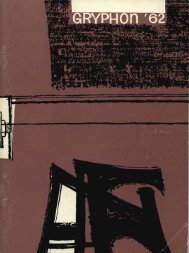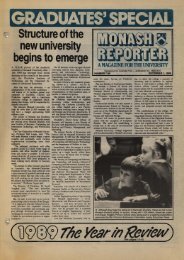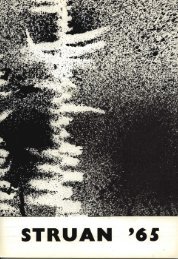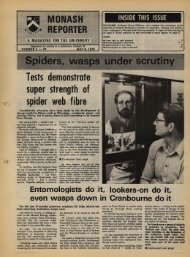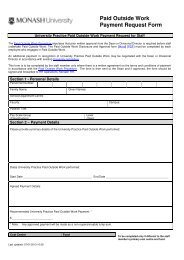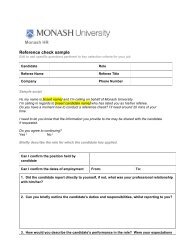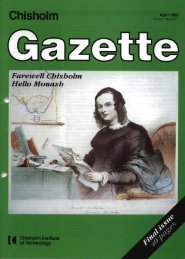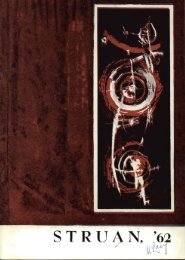GAZETTE - Adm.monash.edu.au - Monash University
GAZETTE - Adm.monash.edu.au - Monash University
GAZETTE - Adm.monash.edu.au - Monash University
- No tags were found...
You also want an ePaper? Increase the reach of your titles
YUMPU automatically turns print PDFs into web optimized ePapers that Google loves.
Ibody compiles a notebook of numbers, which they oftenneglect to carry, and then seemingly tries numbers atrandom!The morning after my arrival I went out to the <strong>University</strong>which is on the northern side of the city on anisland facing the main stream of the Neva River. Thebuildings were constructed between 1722 and 1742, andwere originally built by Domenico Trezzini to house the"Twelve Colleges" of Czar Peter 1. The present <strong>University</strong>'scharter was granted in 1819. Many famousmen of science and letters were students and staff membershere - the chemists Mendeleyev and Butlerov, thephysiologists Pavlov and Sechenov, and the writersChernyshevsky and Turgenev among others. In 1891, atwenty-one-year-old student passed his final exams andwent on to become the <strong>University</strong>'s most famous graduate- Vladamir Ilyich Lenin.At the present time the <strong>University</strong> has some 20,000students in fourteen faculties (with over 3,000 professorsand teachers) occupying the twelve original buildingsand a clutter of smaller buildings packed in between themain ones. In addition, the <strong>University</strong> utilizes otherbuildings in other parts of the city and many laboratoriesare situated in old country houses outside thecity. In spite of this, the <strong>University</strong> is incredibly overcrowded,but nothing can be done on the present campusto alleviate this. A new university is to be built on anew site - when there is finance available. This statementhad a somewhat familiar ring.So intense is the crowding that few academics comeinto the <strong>University</strong> unless they are lecturing, most preferringto work at home or out at one of the laboratories.It was consequently very difficult to meet staffmembers except by prior appointment which often hadto be made a week or more in advance to coincide withthe next time that person would be on campus. Nor isthere any place where the staff meet socially, such ascoffee rooms or faculty dub, although there are small"cafes" scattered around the various buildings, somerestricted to staff, the rest for both staff and students.Near the <strong>University</strong> is a large cafeteria where staff andstudents often eat, and where the meals are cheap andsubstantial. There is no student union, but students areoften members of youth clubs in various parts of thecity. On campus there is also a medical facility, theAuthor (left) with his interpreter, Sasha Dolinini, athird year English student at Leningrad <strong>University</strong>,outside the house of the artist Repin, 60 km. north ofLeningradFaculty of Science and <strong>Adm</strong>inistration building, <strong>University</strong>0/ Leningrad. The building in the backgroundis the facuIty of PhilologyPolyclinic, where staff and students can obtain medicaladvice and treatment, and limited pharmaceutical service.The <strong>University</strong> library is quite a large one, with overthree million volumes, parts of the collection going backto the foundation of the school. Hence it contains muchof considerable historical interest, although within thescientific field it was very short on many standard textsand journals. This is apparently due to the shortage offoreign exchange that can be diverted to such "nonessential"purchases. The librarian was very interested inexchanging books and journals originating in the U niversityfor subscriptions to Western journals and for books.On this first visit to the <strong>University</strong> I was greeted bythe Vice Pro-Rector with a long speech of welcome, andthen I was taken to meet the members of the departmentof Entcmolgy. To reach it, we went up to thefirst floor of the building and turned into a corridor thatran right down one side of it. The corridor was fullytwenty-five feet wide and two hundred and fifty yardslong, and lined with busts, paintings and statues ofLeningrad's famous men. Bookcases spilled over fromthe library at the opposite end of the corridor, andsuperimposed on all were student posters protestingc<strong>au</strong>ses such as the Vietnam war, or featuring highlightsof vacation field trips. Shades of the Union lobby!I was introduced to the staff and students of theEntomology department, and received a major shock,I had been told that nearly everybody at the <strong>University</strong>spoke English, but now I found that in fact onlytwo of the staff did so. This, I thought, will make Iecturinginteresting. That particular problem was someway off, as it turned out, for my lecture notes andbooks were in my unaccompanied luggage, still somewherebetween Melbourne and Leningrad. Until myluggage (which also contained most of my warm clothes)arrived, I decided to be a tourist.As well as receiving a daily living allowance, I wasentitled to use a ch<strong>au</strong>ffered car for six hours per day,so on any day that the weather looked at all reasonableI went out into the country around Leningrad, and whenthe weather was poor, which was most of the time, Iwent the tourist round of museums and art galleries.The <strong>University</strong> had provided me with a guide and interpreter,an enthusiastic young third year English student,Sasha Dolinin. And Leningrad is a marvellous17




